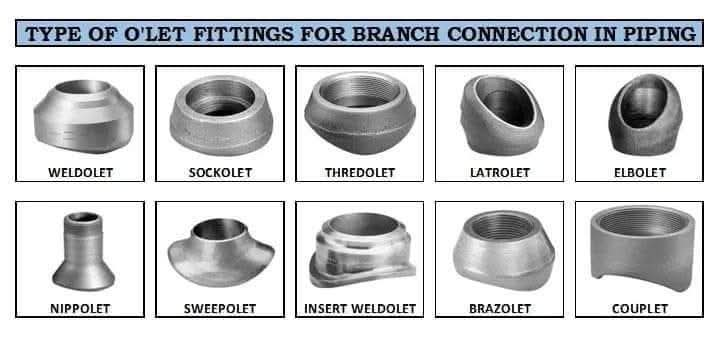What is a Weldolet Fitting? Types, Standards & Applications Guide
In high-pressure industrial piping systems, selecting the right branch connection is critical for safety and performance. Among the most efficient and reliable options is the Weldolet — a type of integrally reinforced outlet used to connect branch pipes to a run pipe at 90°.
This guide explains everything you need to know about Weldolet fittings — from types, materials, and dimensions to how they compare with Sockolets, including industry standards like MSS SP-97.
What is Weldolet?
A Weldolet is a butt-weld pipe fitting designed to create a 90-degree branch connection between a larger pipe (the run) and a smaller pipe (the branch). It’s part of the “Olet” family of outlet fittings and is engineered to reduce stress concentration and ensure a smooth flow transition.
Weldolets are widely used in industries such as:
- Oil & gas
- Petrochemicals
- Shipbuilding
- Dairy and pharma
- Power plants
These fittings are especially useful in systems using stainless steel pipes or seamless pressure piping.
Weldolet vs Sockolet: What’s the Difference?
Both fittings create a branch from a header pipe, but their design and use differ:
| Feature | Weldolet | Sockolet |
|---|---|---|
| Connection Type | Butt-weld | Socket-weld or threaded |
| Pressure Handling | Higher pressure systems | Lower to medium pressure |
| Typical Use | Large-diameter, critical lines | Small bore, non-critical service |
| Standards | ASME B31.3, MSS SP-97 | ASME B31.1, B31.3 |
For systems handling aggressive or sanitary fluids (like dairy valves or CIP systems), Weldolets offer superior strength and hygiene.
Weldolet Types and Sizes
Weldolets are available in various configurations:
- Standard Weldolet – For equal-size 90° branches
- Reducing Weldolet – For reducing pipe sizes
- Customized Weldolets – For specialty pressure classes or geometries
Common Size Range:
- Run pipe: 2″ to 60″
- Branch pipe: ½” to 36″
- Schedule: STD, 40, 80, 160, XXS
When sizing, ensure compatibility with SS tubes or boiler tubes to maintain flow integrity.
MSS SP-97: Weldolet Standard
MSS SP-97 governs integrally reinforced outlet fittings, including Weldolets. It defines:
- Dimensions and tolerances
- Welding bevels
- Wall thickness ranges
- Acceptable materials and grades
Weldolets complying with this standard offer assurance in safety-critical applications such as steam systems, CIP pipelines, and sanitary conical strainer assemblies. Learn more about options like conical strainers for clean flow systems.
Material Grades: Stainless Steel and More
Weldolets are available in several grades to match different pipe materials and media:
- SS 304 / 304L – General corrosion resistance
- SS 316 / 316L – Ideal for sanitary, marine, or chemical applications
- Carbon Steel (ASTM A105) – For oil & gas
- Alloy Steel (ASTM A182 F11/F22) – High-temperature service
- Super Duplex – Excellent strength and pitting resistance
They’re especially effective when used in pharmaceutical piping or with sanitary valves where hygiene is critical.
Buttweld Branch Connection: Why Use Weldolet?
The butt-weld design of a Weldolet ensures:
- Better stress distribution
- Lower turbulence
- A clean, flush internal finish
- Less risk of leakage
- Long service life
This makes them superior to threaded or socket-weld branches in hygienic, high-stress, or high-flow systems.
Installation Overview
Installing a Weldolet involves:
- Cutting a hole in the header pipe
- Aligning the fitting and preparing the weld ends
- Welding the Weldolet to the header
- Joining the branch pipe with a butt-weld
- Testing for joint strength (hydro or radiographic tests)
For systems requiring frequent cleaning or inspection, consider using SS flanges in adjacent connections.
Advantages Over Tee Fittings
- Better flow characteristics
- Smaller footprint
- Higher pressure class
- Seamless installation with pipes of differing sizes
- Cost-effective for large-diameter branches
Especially where torque loads or space-saving are a concern, Weldolets outperform standard tee joints.
Applications of Weldolet Fittings
- Mainline process piping
- Steam and condensate systems
- Heat exchangers
- Dairy, beverage, and pharmaceutical pipelines
- CIP loops in cleanroom environments
- High-pressure chemical transport
They’re especially useful where branch pressure needs to match the header, such as in boiler piping systems.
Final Thoughts
Weldolet fittings are the industry’s go-to choice for reinforced, high-integrity branch connections in both industrial and sanitary piping systems. With their stress-resistant design, wide material availability, and MSS SP-97 compliance, they provide reliable performance across sectors.
Whether you’re designing a pressure-critical steam header or building a dairy-grade CIP loop, understanding Weldolet types, standards, and sizing ensures you make the right decision for safety and flow efficiency.
If you’re working with stainless or alloy piping, or managing process control systems with dairy valves or SS pipes, Weldolets are a perfect match for long-term reliability.
Frequently Asked Questions (FAQs)
Q1. Can Weldolets be used in hygienic applications?
Yes. SS 316L Weldolets with polished internal surfaces are suitable for dairy, pharma, and food-grade piping.
Q2. What’s the difference between a Weldolet and a tee?
A Weldolet is a reinforced branch outlet welded into the pipe, while a tee is a pre-shaped fitting requiring more space and often creates more turbulence.
Q3. Are Weldolets available in reducing sizes?
Yes. Reducing Weldolets are commonly used to connect a smaller branch to a larger header pipe.
Q4. How do I ensure Weldolet compatibility with existing pipes?
Match the schedule and grade of the pipe. Use MSS SP-97 compliant dimensions for fit accuracy.
Q5. What tools or accessories should be used with Weldolets?
Depending on the application, accessories like conical strainers or sanitary valves may be required downstream.

